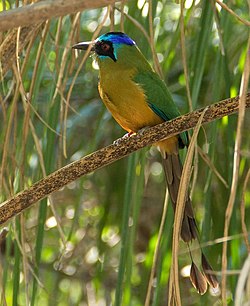Top Qs
Timeline
Chat
Perspective
Amazonian motmot
Species of bird From Wikipedia, the free encyclopedia
Remove ads
The Amazonian motmot (Momotus momota) is a colorful near-passerine bird in the family Momotidae. It is found in the Amazon lowlands and low Andean foothills from eastern Venezuela to eastern Brazil and northeastern Argentina.[2]
Remove ads
Taxonomy and systematics
The Amazonian motmot and the blue-capped (Momotus coeruleiceps), whooping (M. subrufrescens), Trinidad (M. bahamensis), Lesson's (M. lessonii), and Andean motmots (M. aequatorialis) were all at one time considered conspecific.[3][4][5] The Amazonian motmot has nine recognized subspecies; they are listed in the "Distribution and habitat" section below.[2]
Description

The Amazonian motmot's plumage varies among the subspecies. The bodies of all are shades of green. All have a long tail that has extended feathers with racquet tips that are green or black. Most have a black eyemask, though their size and shape differ. The central crown is black and surrounded or partially bordered by a blue band. The nominate subspecies has a chestnut nape. Momotus momota ignobilis and M. m. cametensis have more extensive chestnut on the neck and face.[4]
Remove ads
Distribution and habitat
The Amazonian motmot is widely distributed in South America east of the Andes. Nine subspecies are recognized:[2]
- Momotus momota momota — eastern Venezuela, Guyana, Suriname, French Guiana, and northern Brazil
- M. m. microstephanus — southeastern Colombia, eastern Ecuador, and northwestern Brazil
- M. m. ignobilis — eastern Peru and western Brazil
- M. m. nattereri — northeastern Bolivia
- M. m. simplex — western to west central Brazil south of the Amazon
- M. m. cametensis — north central Brazil
- M. m. parensis — northeastern Brazil
- M. m. marcgravianus — eastern Brazil
- M. m. pilcomajensis — southern Bolivia, southern Brazil, and northwestern Argentina
Throughout its range the Amazonian motmot inhabits the interior and edges of humid lowland forest. It is found up to 1,200 m (3,900 ft) in Venezuela, to 1,000 m (3,300 ft) in Ecuador, and to 750 m (2,460 ft) in Peru.[4]
Behavior
Feeding
The Amazonian motmot is omnivorous. It has been documented eating insects and other arthropods, small mammals and reptiles, and fruit.[4]
Breeding
Like most Coraciiformes, the Amazonian motmot nests in long tunnels in earth banks. Very little else is known about its breeding phenology.[4]
Vocalization
The Amazonian motmot's song has been described as "a fast, hollow hoo-do" and "a bubbling whOOP-oo". It also makes "a gruff kak", sometimes in a series.[4]
Remove ads
References
Wikiwand - on
Seamless Wikipedia browsing. On steroids.
Remove ads



